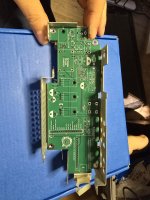I have four main boards one I bought as a bare board and three other I picked up in supposedly dead machines. So far, I've found a couple of the large caps on the main board leaked and power supplies that were almost trashed from leaking caps. The contrast and volume pots are also touchy. Other than that all of the main boards except one has actually come out ok after replacing those two caps (a 470uf 10v by the power lead and 1000~1200uf 10v over by the big transformer near the lcd connector). The one that failed seems to have a bad keyboard controller or something else wrong with that part of the system. Of the three machines that I've played with all of the backlights came back and the lcds work, though two of them have minor issues that seem to be causes by physical damage. Floppy drives seem to be iffy, I've got about 5 of them now between the machines. 2 work and the others I'm pretty sure have leaking caps that I haven't tracked down. A slightly modified gotek, to deal with the power pins that normally are ground lines, seems to work fine but you need one without an rotary encoder and can't leave even small form factor usd drives plugged in and close the lid. The one machine a I had with an hdd seems to have leaky caps on the hdd itself and I haven't dug into it yet to try to repair that. The xt-ide board for the 1400 will work, with the very late unit version of the xt-ide bios, but you can't use ctrl-alt-del with it last I checked.
All that to say the internal psu's are basically trash, but can be recapped if they haven't blown other parts (that's why I started looking into replacements). You may also have to readjust the voltages to the correct values, my boards don't seem to play nice with voltages below 5v and really need those two Rubicon caps on the board replaced. The mainboards themselves and lcds seems to pretty resilient based on the specimens I have. Personally, I'd pull your "dead" machines appart, check the fuses, and replace *all* of the electrolytic on the psu board, the little daughter card, and any that look suspect on the main board. So long as the volume trimmer and contrast know aren't damaged and the lcd is intact, it might just power up. You will want to clean up the cap juice and corrosion of course. Recapping took me about 2~3 hours cleaning as I went. In my case, the Rubicon caps were the bad ones, most of the other brands seemed to be fine.
Really need to write this up in a blog post ...










